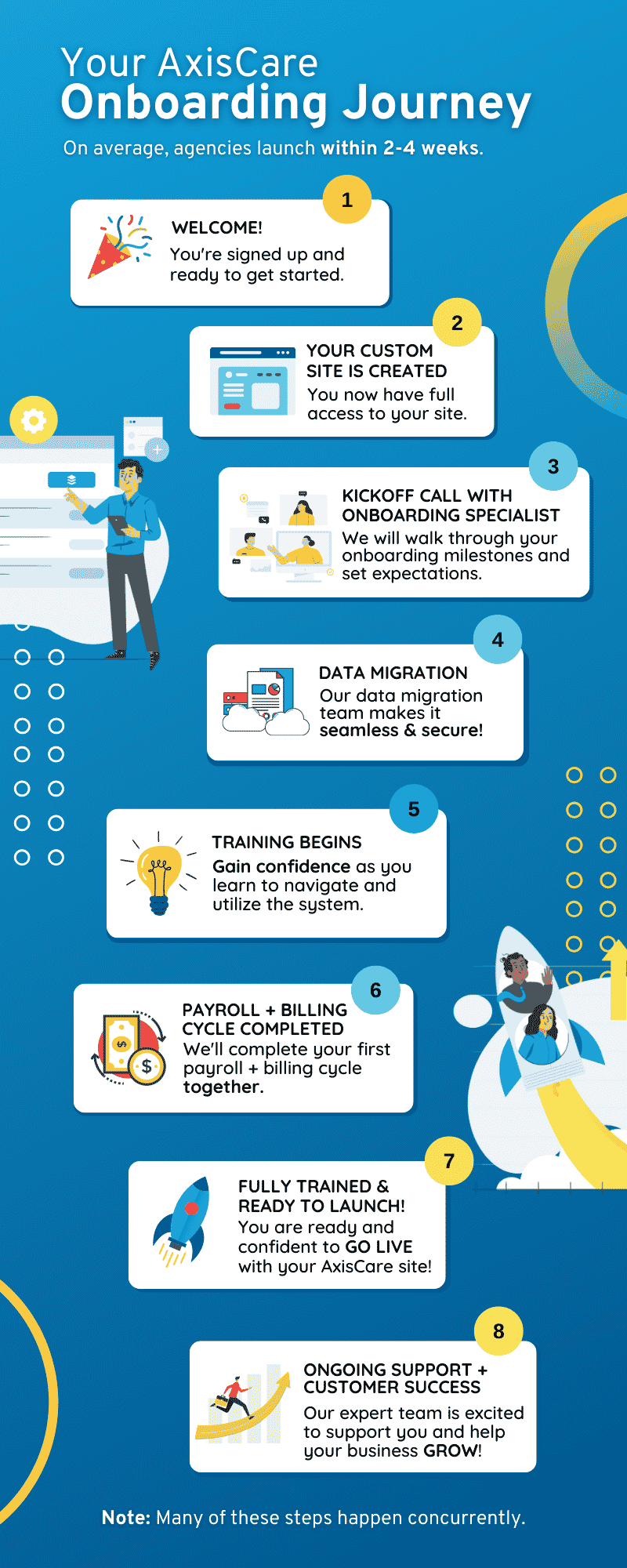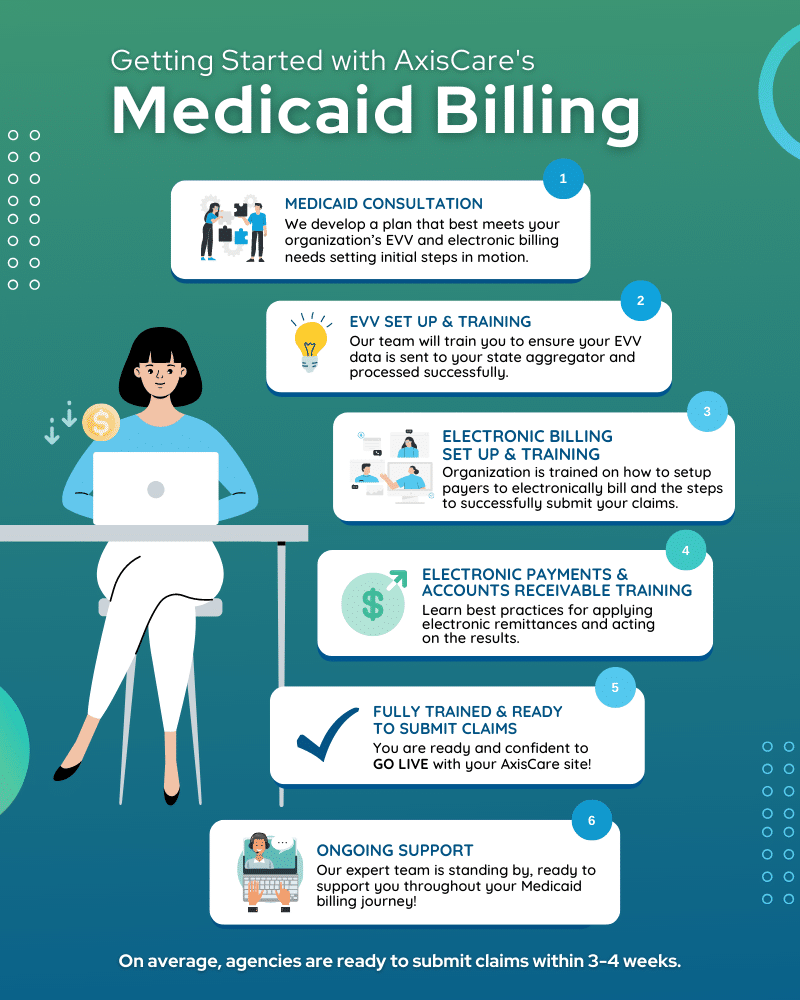AI in Home Care
AI in home care refers to the use of artificial intelligence technology to enhance support for elderly individuals, people with chronic conditions, and the caregivers who support them. AI is often embedded within home care management software, helping agencies and their teams analyze data, detect trends, and automate routine tasks to improve efficiency and personalization.
Rather than replace employees, AI should be a toolkit that complements and augments their skills, taking menial work off their plates so they can focus on higher-level priorities.
What is AI in Home Care?
General healthcare AI differs from how AI is being used in home care. In hospital or clinical settings, AI is typically used to support diagnostics, imaging analysis, and treatment planning. On the other hand, AI in home care focuses on daily support, client safety, and helping individuals live a more independent life at home.
While hospital AI might help a doctor interpret a scan or predict likely risks related to a given surgery, home care AI is designed to provide medication or appointment reminders, recognize changes in behavior or movement, and other supports that promote safe and consistent care.
How AI is Used in Home Care
Remote Monitoring & Health Tracking
Remote monitoring devices keep tabs on clients’ movements as they go about their days. Whether it’s someone who lives alone or has mobility challenges, these AI-augmented sensors and wearables make sure they remain safe as they move through their homes and send out an alert if something seems amiss. They can collect a diverse range of health data depending on which device is being used, including heart rate, blood pressure, oxygen levels, sleep quality, and mobility patterns.
These wearables are therefore a rich source of data for predictive analytics. For example, cross-referencing the information collected by a wearable device with electronic health records can identify trends and flag a potential health decline down the road.
Certain devices can also detect falls or prolonged inactivity in real time, and algorithms can be trained to distinguish between normal movements and potential injuries. As soon as an intervention is needed, the software can send automatic alerts to caregivers or family members, preventing emergencies from escalating and cutting down on hospitalizations.
Virtual Assistants and Companionship
Beyond tracking vital signs, AI technologies also assist with daily routines and planning, learning each person’s habits to provide reminders for meals, medications, exercise time, or appointments. With just a few nudges in the right direction, older adults living independently can do so with far more ease and confidence.
Without a caregiver watching around the clock to make sure clients are taking their medication, for example, adherence can be a real challenge. To combat this, AI-powered systems use voice interaction, smart dispensers, and continuous monitoring to remind individuals when it’s time to take their medications. They can also notify caregivers of any missed doses.
Beyond physical health, combating isolation is a significant concern in home care. People who live in a care facility can benefit from organized community events, while individuals who choose to stay in their homes don’t necessarily have as many opportunities to socialize. AI-powered companions can converse and engage in ways that promote mental stimulation and reduce loneliness when in-person contact isn’t readily available.
Caregiver Scheduling
AI can be used to streamline operations for in-office staff. Intelligent scheduling and routing tools make it easy to assign shifts based on caregiver availability and clients’ needs, while apps allow employees to verify visit details and standardize appointment data using an app. By identifying overburdened schedules or lopsided overtime, AI can also ensure caregivers get as many of their preferred hours as possible.
Many platforms also feature built-in compliance tools to keep agencies in line with complex federal and state-level regulations. When creating invoices for payers, service details must be matched to a unique code and be perfectly aligned with the client’s care plan, leaving very little room for error on administrators’ parts. If even one data field is out of place, agencies can face repayment delays, fines, and even service interruptions.
Benefits of AI in Home Care
In a broad sense, AI in home care helps in-office staff and caregivers stay on top of clients’ conditions, react faster in the event of an incident, and keep schedules aligned with staff and client preferences. These days, there is simply no need to bog administrators down with busywork or fill caregivers’ plates with rote tasks: AI can enable deeply personalized client care, pave the way for proactive interventions, and rely on huge quantities of data to facilitate quicker and more accurate decision-making.
Challenges and Considerations
Health care AI offers countless benefits, but its adoption also comes with important ethical, financial, and practical considerations. One of the most pressing is data privacy and security: since AI systems collect sensitive health information, agencies and software providers must ensure strict compliance with regulations like HIPAA. Encryption and clear consent processes are also a must, so clients and their families can be sure their data is being handled with care.
Reliance on technology is another thing to keep in mind. While AI is certainly a boon for operational excellence, it should never be used to replace human input entirely. Agencies may be left high and dry if they lean on it too heavily: if systems malfunction, for example, caregivers should be able to step right back in and get the job done.
Some agencies may face financial barriers to AI adoption. Though the efficiency unlocked through these tools can reduce long-term expenses, there is still a significant upfront investment required for the necessary hardware, software, and training.





